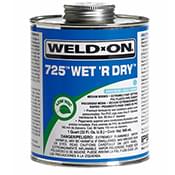Replacing pool equipment in your system can be expensive, but why pay for a professional when you can do the job yourself? Save on the cost of repairing and maintaining your pool by following these simple steps for gluing pool fixtures together.

Pick the Right Glue
Most of the pieces of your pool circulation system will be permanently attached to one another with PVC cement. This is so that the system can withstand harsh conditions and last a long time. Unfortunately, it also means that you will have to cut cemented fixtures out of your piping system, and then reattach them yourself.
To do so you need to choose the right adhesive. There are a number of products on the market that are suitable. Using PVC cement is the obvious choice, after all the original installers used it for a reason: it is strong, and reliable.
A quarter of a pint of PVC cement will generally run as high as $20 or more. At Pool Supplies Canada you can often find IPS 795 PVC Cement on sale for as low as $10. It is suitable for use on all applications, including flexible to rigid applications.
Here’s another cost saving tip - you can usually get IPS 725 Wet R Dry Glue for a bit cheaper for the same quantity than higher end glue like Mr. Sticky Underwater Glue (which tends to cost almost a dollar more per gram). However, the extra cost buys you extra peace of mind. Mr. Sticky Underwater Glue combines the strength of epoxy and the resilience of rubber for a vibration, shock, and twist resistant seal.
To apply your adhesive you’ll also first need to apply the right primer. Again, the best value for this is from Pool Supplies Canada where you can get Weld-On IPS P-68 Primer (in clear or dark) for about $10 less than you’ll find elsewhere.
The most important consideration, however is not cost. You want to ensure that you use PVC cement or glue that is purpose-built for pools. Water, chlorine, salt, and other chemicals and compounds can cause other adhesives to degenerate.
Gluing Your Pool Fixtures Together
Once you have the right glue, you need to assemble the other necessary tools. This will include:
After you’ve assembled all the necessary tools and materials, gluing your pool fixture together can be done in just seven easy steps.
Step 1: Cut the Pipe
Before replacing the fixture you first need to cut the old piece of equipment out of the piping system. To cut the pipe you can choose to use a portable power saw, but a hand held saw or PVC pipe cutting tool will work just as well. The important thing is that the cut is as straight and smooth as possible. If you choose to use a saw, make sure it has a sharp blade. Avoid forcing the cut - when you put a lot of pressure on the blade it tends to bend and go off-centre.
Step 2: Smooth the Edges
Smooth and clean the outside and inside edges of the newly cut pipes. Smoothing the edges is important for the same reason that a straight cut is important: attaching a new fixture to damaged or angled pipes is much harder than dealing with a smooth, straight cut. Using a metal file is the easiest way to smooth the edges, but if you don’t have one then you can always use sandpaper.
Step 3: Clean the Pipes and Fixture
Use a clean rag to clean the inside of the fixture, and the inside and outside of the PVC pipes. Doing so will help the glue adhere better and protect the fixture itself from any contaminants that could affect its function.
Step 4: Glue It Together
Attaching the new fixture means that you have to place it back in the piping system by gluing it to the PVC pipes that you cut previously. To do so:
Troubleshooting Common Issues
Skimmers and pumps: The most common fixtures that need to be replaced are skimmers and pumps which can be damaged by a range of potential issues, or simply wear out over time. Consulting a professional is always advisable but if you know what the problem is and can get the replacement fixture for a good price then it will be much more inexpensive to fix the skimmer or pump yourself.
Leaks: Some of the most common issues that necessitate the replacement of fixtures or pipes involve leaks in the plumbing. Finding the leak can be very difficult. For a small leak you can find repair kits, but be careful as not all repair kits come with glue, so make sure you double check the packaging first. In certain cases, you may need to replace the entire fixture or a length of pipe, and in such scenarios you can use the method and materials highlighted above with some modification.
Enter your postal code to check your area.